Samsung Galaxy S 6 and S 6 Edge: Preview
by Joshua Ho on March 26, 2015 9:00 AM EST- Posted in
- Smartphones
- Samsung
- Mobile
- Galaxy S6
- Galaxy S6 Edge
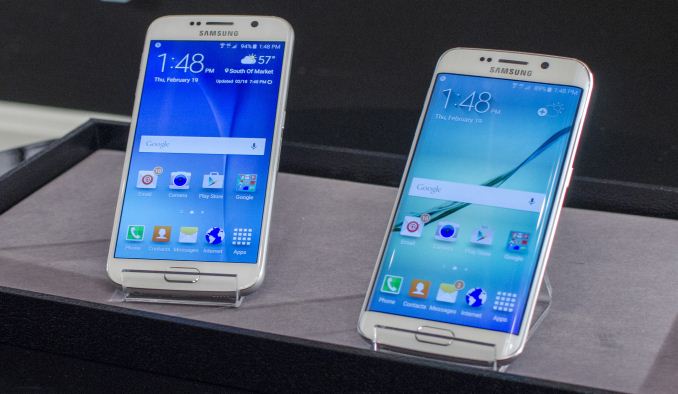
Yesterday we received our Galaxy S6 and S6 edge review units. We’re still working on the final review but I wanted to share some early results from both devices. For those that are unfamiliar with these two phones, the Galaxy S6 range represents the result of Samsung’s “Project Zero”. In fact, the phones seem to have the internal name of Zero, which can be seen in terminal, and the build properties of both devices. For Samsung, these phones represent their attempt at completely rethinking how Samsung makes phones. There is a strong emphasis on a new unibody design, which has no visible gaps or screws. Rather than the plastic that previous Samsung phones have been known for, the new design is composed of metal and glass. Samsung’s design team has been given unprecedented control throughout the process of making this phone and the result of this is a Galaxy phone that looks unlike anything else they’ve ever released.
Even if design is important, it isn’t enough to make the phone. Samsung has also outfitted the Galaxy S6 and S6 edge with their latest technologies, from a new AMOLED display to a new camera module. The specs for both phones can be seen below.
| Samsung Galaxy S5 | Samsung Galaxy S6 | Samsung Galaxy S6 Edge | |
| SoC | MSM8974ACv3 2.45 GHz Snapdragon 801 | Exynos 7420 2.1/1.5GHz A57/A53 | Exynos 7420 2.1/1.5GHz A57/A53 |
| RAM/NAND | 2GB LPDDR3 16/32GB NAND + microSD |
3GB LPDDR4-1552 32/64/128GB NAND |
3GB LPDDR4-1552 32/64/128GB NAND |
| Display | 5.1” 1080p SAMOLED HD |
5.1” 1440p SAMOLED |
5.1” 1440p SAMOLED, Dual Edge |
| Network | 2G / 3G / 4G LTE (Qualcomm MDM9x25 UE Category 4 LTE) | 2G / 3G / 4G LTE (Category 6 LTE) | 2G / 3G / 4G LTE (Category 6 LTE) |
| Dimensions | 142 x 72.5 x 8.1 mm, 145 grams | 143.4 x 70.5 x 6.8mm max, 138 grams | 142.1 x 70.1 x 7.0mm max, 132 grams |
| Camera | 16MP (5132 x 2988) Rear Facing with 1.12 µm pixels, 1/2.6" CMOS size, 31 mm (35mm effective), f/2.2 | 16MP (5132 x 2988) Rear Facing w/ OIS, f/1.9, object tracking AF | 16MP (5132 x 2988) Rear Facing w/ OIS, f/1.9, object tracking AF |
| 2MP Front Facing | 5MP Front Facing, f/1.9 | 5MP Front Facing, f/1.9 | |
| Battery | 2800 mAh (10.78 Whr) | 2550 mAh (9.81 Whr) | 2600 mAh (10.01 Whr) |
| OS | Android 4.4 w/TouchWiz |
Android 5 (64-bit) w/TouchWiz | Android 5 (64-bit) w/TouchWiz |
| Connectivity | 802.11a/b/g/n/ac 2x2 + BT 4.0 (BCM4354), USB3.0, GPS/GNSS, MHL, DLNA, NFC |
2x2 802.11a/b/g/n/ac + BT 4.1 (BCM4358), USB2.0, GPS/GNSS, NFC |
2x2 802.11a/b/g/n/ac + BT 4.1 (BCM4358), USB2.0, GPS/GNSS, NFC |
| Wireless Charging | N/A | WPC 1.1 (4.6W) & PMA 1.0 (4.2W) |
WPC 1.1 (4.6W) & PMA 1.0 (4.2W) |
| Fingerprint Sensor | Swipe | Touch | Touch |
| SIM Size | MicroSIM | NanoSIM | NanoSIM |
Both the Galaxy S6 and S6 edge have Samsung System LSI’s newest SoC, the Exynos 7420, which has a cluster of four Cortex A57s clocked at 2.1 GHz, and four Cortex A53s clocked at 1.5 GHz. Compared to the Exynos 5433 of the Galaxy Note 4, this brings a new 14nm LPE (low power early) process, an upgrade to LPDDR4 memory, and a Mali T760 GPU with two additional shader cores. Outside of the SoC, the new display is advertised to bring a higher 600-nit brightness and a higher 1440p resolution. The front and rear cameras are both different from the Galaxy S5 as well, although the rear camera sensor may be shared between the two as the camera sensors are of similar spec. For this preview, we’ll focus on the system performance and display of these new devices, but as one can see from the specification table there is far more to look at for the full review.
System Performance
For our system performance benchmarks we’ll start with our browser tests which can give a rough proxy for overall CPU performance.
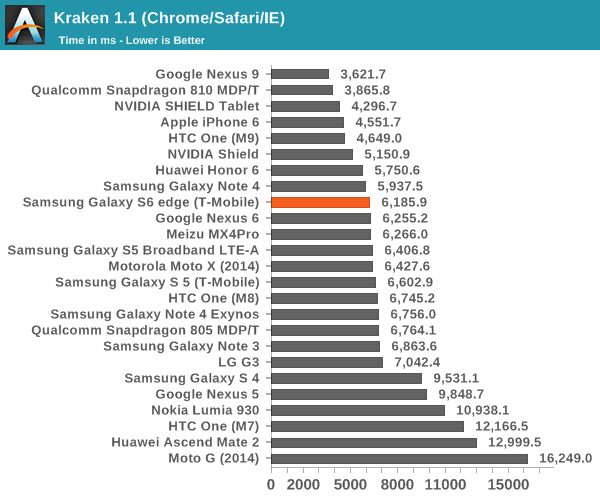
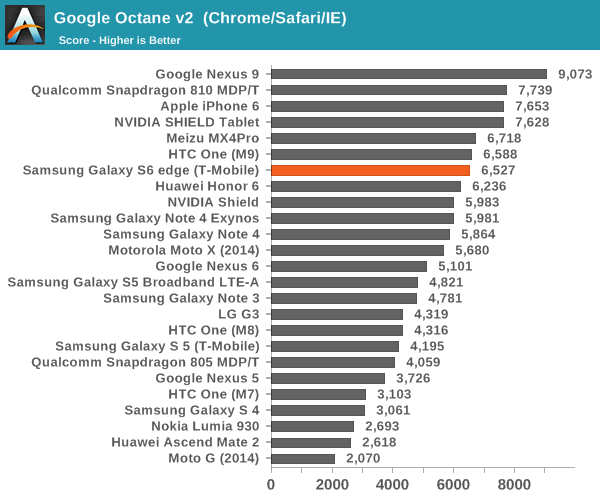
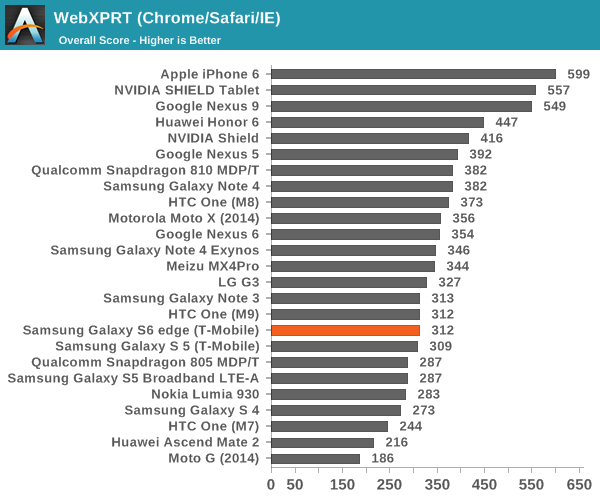
The Exynos 7420 is about on par with the Snapdragon 810 in these benchmarks. Strangely enough both tend to do worse than the Huawei Honor 6 in these tests, which clearly can't be correct. As we've previously discussed, the stock browser will often give far better results due to OEM and SoC vendor optimizations. As a part of our updates to the benchmark suite for 2015, we'll take a look at Basemark OS II 2.0, which should give a better picture of CPU performance in addition to overall device performance.
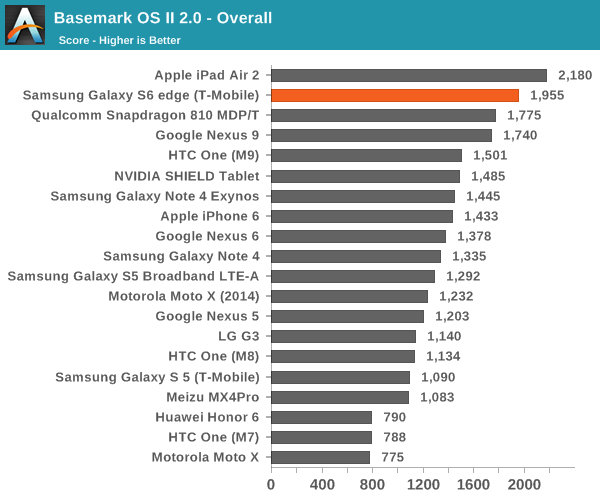
The browser benchmarks seem to hide some pretty enormous variability as the Galaxy S 6 edge (which is comparable to the Galaxy S 6) sets a new record among Android devices. The only challenger is the iPad Air 2, which uses the A8X SoC with three Enhanced Cyclone cores and the semi-custom GXA6850 GPU.
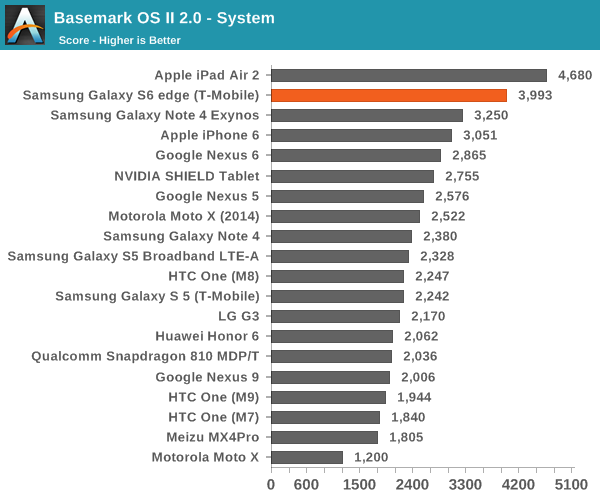
This system test contains a floating point and integer test, in addition XML parsing, which means that this test mostly stresses CPU and RAM. Interestingly enough, the Exynos 7420 pulls far ahead of both the Exynos 5433 and Snapdragon 810 in this test, and approaches the A8X. The difference between the 5433 and 7420 is likely a combination of the higher clocks on both the A57 and A53 clusters for the 7420 (1.9/1.3 on the 5433, 2.1/1.5 on the 7420), in addition to the ability to stay at a high 'overdrive' clock due to reduced leakage from the 14LPE process. The One M9 likely falls a bit short here due to HTC's governor settings restricting the use of all 8 cores simultaneously.
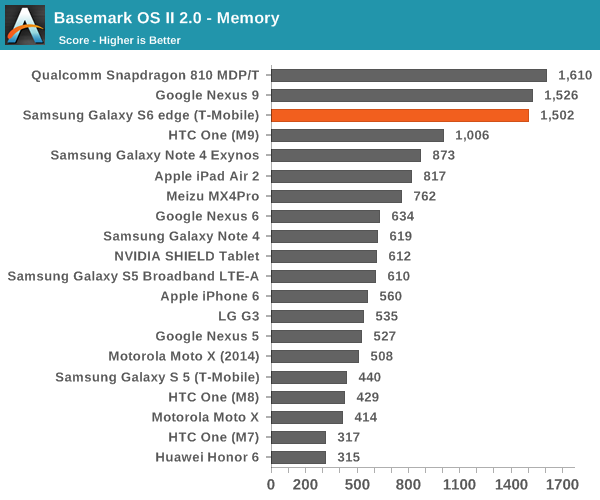
While one might guess that the memory test of 'Basemark OS II 2.0 - Memory' is of RAM, this is actually a test of the internal storage. Once again we see the S6 edge come close to leading the pack due to the use of the new UFS (Universal Flash Storage) standard. Casual examination reveals that the S6 edge has a queue depth of 16, and that it identifies itself with the rather cryptic model name of KLUBG4G1BD-E0B1.
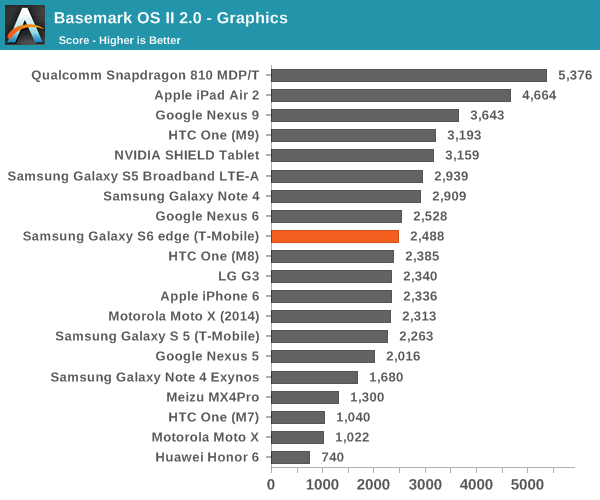
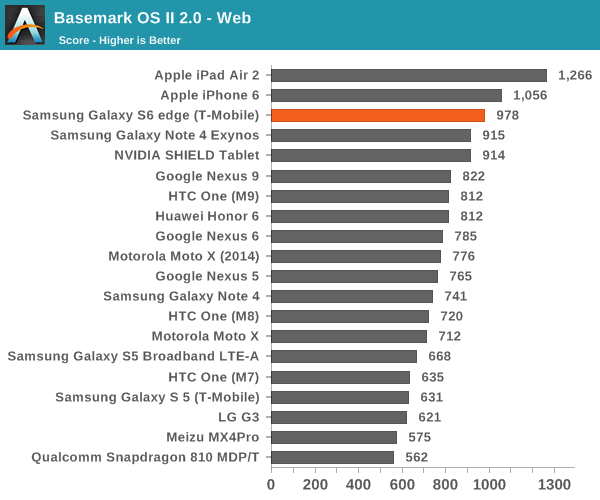
For the web test, it uses the built-in WebView rendering engine rather than Chrome and paints a distinctly different picture, especially because these tests are focused on HTML5 and CSS rather than JavaScript. Here we can see that the iPhone 6 and iPad Air 2 continue to hold their lead, but the Galaxy S6 is pretty much the king of the hill when it comes to Android devices.










200 Comments
View All Comments
Refuge - Thursday, March 26, 2015 - link
No, like comparing apples, and bigger apples.mkozakewich - Thursday, March 26, 2015 - link
But those apples are bigger! You can't compare them, because they're more like oranges now....I wonder what the differences are between apples, big apples, and oranges.
SunnyNW - Thursday, March 26, 2015 - link
Is the Exynos 7420 fully 64-bit enabled unlike the 5433?Andrei Frumusanu - Thursday, March 26, 2015 - link
Yes.phoenix_rizzen - Thursday, March 26, 2015 - link
Read the specs table. It lists it as shipping with the 64-bit version of Android 5.0 installed.lilmoe - Thursday, March 26, 2015 - link
I've had this on my mind for quite a while, but ever since the Snapdragon throttling fiasco, I've took further notice in throttling and its effects on usability and benchmarks of smartphones, and lots of past thoughts have become clearer to me.In that regard, I believe some cross-platform benchmarks are worth investigating since some (geekbench particularly) do NOT have the same running times for each platform. When the A7 was released with better single thread performance, I thought the running time of Geekbench on iOS was too short compared with that on Android, but I sort-of dismissed that thinking that maybe the benchmark was stressing AES and other ARMv8 enhanced instructions more than others, thus finishing faster since they were much faster on ARMv8. But when Android was getting powered by ARMv8 processors AND scoring higher than the A8, things have become alarming to me.
Thus my conclusion; Geekbench, among other benchmarks, are NOT calculating their scores fairly across platforms. For iOS in particular, the running time of the benchmark is noticeably shorter thus not stressing the SoC enough for thermal throttling to kick in. I'm therefor debunking ALL cross-platform benchmarks as not being consistent/reliable for cross platform measure of performance.
It would really be helpful if Anandtech spare some time in either proving or disproving this theory, just like they did with the benchmark "cheating" fiasco. Also, it would also be wise to fully throw Chrome out of the picture and ONLY use the stock browser (if present) and not only give that piece of info a mention deep in the article if you're going to insist on using a "Browser benchmark" for testing cross-platform CPU performance (which shouldn't be the case in the first place).
Thanks.
Andrei Frumusanu - Thursday, March 26, 2015 - link
You're demanding that benchmarks use fixed run-time instead of fixed workload. Fixed workload is still a much better representation of performance.MrCommunistGen - Thursday, March 26, 2015 - link
I think what lilmoe is trying to say is that based on his observations, benchmarks like Geekbench might *not* be using the same fixed workloads across platforms.Disclaimer: I'm not supporting either side of the argument, just attempting to clarify.
lilmoe - Thursday, March 26, 2015 - link
+1If they were running the same workload, how can a device score higher and finish the test much later... Every passively cooled performance processor throttles under constant stress conditions, and the difference in performance is significant.
MrCommunistGen - Thursday, March 26, 2015 - link
I think they're using Chrome so that all Android devices are tested on an even footing (the same browser). It may not be well optimized, especially on newer platforms, but at least the devices are using the same rendering engine, etc. I'm sure there's tons of arguments here, but that's my 10-second thought process.Also, I'm not sure if I'm alone in this, but I ditched the stock browser years ago during the Gingerbread days when I actually started heavily using my devices. I worked at a cellphone store at the time and switched phones often. The inconsistency between stock browsers (speed, page rendering, and UX differences) caused me to pick a common browser across devices - I think at the time I was mostly using Dolphin.
These days, for better or worse, I almost exclusively use Chrome - Some of that might be because my last device was a Nexus 5. I'll hop over to Firefox if something renders strangely in Chrome or sometimes just to see how the browser is doing, but I don't think I've ever launched the "Internet" app on my Note 4 (Snapdragon).